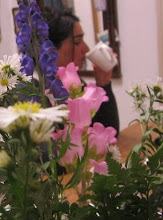Glass-Maps
This entry is dedicated to a special person, i admire, she is an Israeli artist, a poet, a gifted writer and an endless seeker of beauty and creation. She is telling in her Hebrew blog, about a new passion of hers, and it's about Glass beads making, she is also creating the most amazing Crystal thread, as well as many other things. As she made few month ago a ghost map i was stroked by, and as respect for her creation paths, I somehow combined them both: her map quest and her love for Glass, as well as my feeilings towards our little planet earth and it's fragility that seem so concretely this days - here- is, some works regarding all that - all are using Glass to depict Our World and it's political and cultural boundaries that shape identity.

Robert Smithson, Map of Broken Glass (Atlantis), 1969. Lannan Foundation; long-term loan. Photo: Florian Holzherr.

samantha clark. Detail of installation Spill 1998-2002, Glass, Maps
Around 4500 small glass drops each with a tiny fragment of map set behind it, fixed directly to walls and floor.
This work has expanded to include maps of every country it has travelled to for exhibition, and now Italy, France, Scotland, Portugal all feature. This piece originated during a residency at the British Scool at Rome as part of the Helen Chadwick Fellowship 1997-8 and has migrated and grown ever since.
 WORLD MAP
The technique used in the execution of world maps with the metallic geometric shapes utilized the old fashioned solar reflective films of the kind used by jet fighter pilots on their visors in the 1950's. These films, until very recently were still readily available. Rick has also done other maps with polymer texturization to add visual interest to the paintings.
WORLD MAP
The technique used in the execution of world maps with the metallic geometric shapes utilized the old fashioned solar reflective films of the kind used by jet fighter pilots on their visors in the 1950's. These films, until very recently were still readily available. Rick has also done other maps with polymer texturization to add visual interest to the paintings.
Few months ago i was deeply impressed by Mona Hatoum, “Map” an installation about the political and cultural boundaries that shape identity.

Mona Hatoum, “Map” (detail), 1999, mixed media installation, dimensions vary.
Map is made up of clear glass marbles spread across a floor, their arrangement seemingly random until the viewer gradually recognizes continents. National and political borders, though, are not marked. The marbles’ transparency and the fact that they could roll easily suggests the fluid nature of such boundaries. The marbles’ placement on the floor hints at the possibility of walking on them and shifting their arrangement--a metaphor for political instability.
 Mona Hatoum
Mona Hatoum





3 comments:
Tomorrow, I am going to try to post some photographs I took of hand carved wooded carousel horses and other animal on Sunday.
The carousel is the first one my daughter ever rode. She was two years old, and I was just past twenty. The images of the past whirled with the turning of the animals and the hurdy gurdy music contained laughter from the past and the present.
p6t28k4e45 z4u86z0t24 x7o06y8x99 m1u28u9r45 e1s48z1e30 u4u28e9y50
gww156bhui
golden goose outlet
golden goose outlet
golden goose outlet
golden goose outlet
golden goose outlet
golden goose outlet
golden goose outlet
golden goose outlet
golden goose outlet
golden goose outlet
Post a Comment